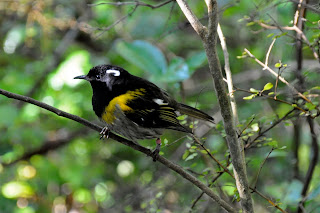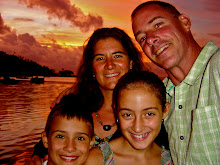| Common Name | Notes |
| Hooded Plover | rare, spotted at Friendly Beaches, Freycinet NP |
| Kookaburra | Very common, very distinctive call |
| Pink Robin | Rare, seen at Platypus Bay, Lake St. Claire NP |
| Shy Albatross | Seen dead on Hazards beach, Freycinet NP |
| Superb Fairy Wren | Most common bird we saw there |
| Tasmanian Native Hen | Seen at Port Arthur on the Tasman Peninsula |
| Welcome Swallow | very common |
| White-bellied Sea Eagle | Seen over the water |
Tuesday, June 29, 2010
Birds of Tasmania by Ian and Tica
Birds of Fiji by Tica and Ian
| Common Name | Notes |
| Barn Owl | heard but not seen |
| Collared Kingfisher | many spotted at the beach and perched on phone wires by the side of the road |
| Collared Lory | Fiji's national bird, often seen in flocks |
| Eastern Reef Egret | seen on the reef all the time, white and grey forms |
| Fiji Goshawk | common |
| Fiji Parrotfinch | seen twice near Waivunia village and at Nadi Airport |
| Great Frigate bird | seen flying over the water all the time |
| Myna | VERY common, very loud |
| Orange Dove | rare |
| Pacific Swallow | common |
| White Rumped Swift | seen over the water all the time catching bugs |
Birds of New Zealand by Tica and Ian
| Notes | |
| Australasian Gannett | yellow head and black at the tip of wings, big breeding colony at Muriwai Bay, we went but they had already flown north toward better weather, saw one in Abel Tasman National Park (South Island) and Otamure Beach on the North Island |
| Australasian Harrier | very common, often seen dining on road kill on the side of the road or surveying fields near the road |
| Australian Magpie | many spotted in fields on the side of the road |
| Australian Pied Cormorant | not very common |
| Bellbird | call similar to a Tui but without the grunts and clicks |
| Black billed gull | very common |
| Black Fronted Tern | rare |
| Black-backed Gull | very common |
| Blackbird | New Zealand's most common bird |
| Brown Kiwi | New Zealand's national bird, looks as though it has as a very long bill, but it has the shortest in the world because scientists measure from a bird's beach from the nostrils; kiwi nostrils are located at the end of the beak so they can rifle through leaves for grubs and things |
| California Quail | seen at many different camps on the North Island |
| Caspian Tern | less common |
| Chaffinch | very common |
| Dunnock (Hedge Sparrow) | very common |
| Eastern Rosella | seen on the North Island in Shakespear Regional Park and in the central North Island, usually seen in pairs |
| European Goldfinch | The most colorful bird in New Zealand; frequently seen in flocks |
| Fantail | flits around like a butterfly; very friendl;. sometimes lands on people |
| Fernbird | seen on Tiritiri Mitangi island |
| Greenfinch | we only saw three |
| Grey Teal | endangered, looks like a female mallard |
| Grey Warbler | |
| House Sparrow | very common in cities and campgrounds |
| Kea | cheeky mountain parrot |
| Kingfisher | mostly on the side of the road near bodies of water and at the beach, don't make noise as much as kingfishers at home |
| Kokako | very rare only seen on the North Island |
| Little Blue Penguin | world's smallest penguin |
| Little Pied Shag | aka cormorant, very common |
| Morepork | owl species that is often heard but seldom seen |
| Myna | only seen on the North Island as they find the South Island to be too cold |
| New Zealand Dotterel | uncommon shore bird, we saw some at Matapuri Bay, North Island |
| New Zealand Falcon | uncommon |
| New Zealand Pigeon | wood pigeon, much bigger than city pigeons, lives in forests, fast whirring wing beats like a city pigeon |
| New Zealand Pipit | we only saw one |
| New Zealand Robin | very small and black with long legs |
| Paradise Shellduck | very common, most often seen in pairs, female has white head while drake has black head |
| Pied Stilt | very common |
| Pukeko | common in fields along the side of roads, especially damp ones, talk with their tails |
| Red Billed gull | very common |
| Red crowned parakeet | extinct on the main islands of New Zealand, found in bird sanctuaries like Tiritiri Matangi |
| Rifleman | Seen at Arthur's Pass National Park |
| Ringed-Necked Pheasant | rather commonly seen in fields |
| Rock Pigeon (City Pigeon) | found mostly in citys |
| Rook | only found on the North Island and only in places on the South Island, look a lot like a crow only bigger |
| Royal Albatross | very large with impressive wingspan, seen on the tip of the Otago Peninsula near Dunedin and at Nugget Point on the east coast, South Island |
| Saddleback | rare |
| Silvereye | very common |
| Skylark | very common |
| Song Thrush | seen at almost all camps on the North Island |
| Southern Crested Grebe | Very rare, only 45 left in the world, seen in just outside of Arthur's Pass NP, South Island |
| Spur-Winged Plover | seen most often on the side of the road, feeding in fields |
| Starling | second most common bird in New Zealand (behind the blackbird) |
| Stitchbird | rare |
| Tomtit | sometimes mistaken for a stichbird |
| Tui | song includes grunts and clicks and high piched peeps |
| Variable Oystercatcher | very common |
| Weka | Odd looking bird, sort of like a cross between a kiwi and a duck, seen around campgrounds on the South Island |
| Welcome Swallow | Flies very fast to catch sand flies |
| White Head | not common |
| White-faced Heron | common around bodies of water |
| White-Fronted Tern | less common |
| Yellow-Eyed Penguin | One world's rarest penguin |
| Yellowhammer | in mountains |
Monday, June 28, 2010
Birds of New Zealand - Pix and Flix
The Bird List Project -- by Tica and Ian
I got into birding and animal watching on this trip. I did not expect it but my sister Tica helped me to become a birder. Everywhere we went this year, be it Fiji, Tasmania, Singapore or New Zealand, we have seen amazing birds, like penguins, fantails, kookaburras, and others. I did not think I would ever see such things in my lifetime. If you look hard enough, you can find unique and very ornate species anywhere you go, like the Superb Fairy Wren of Tasmania or the Collared Lory of Fiji.
The blogposts that follow are ones that Tica and I worked on together and will detail birds that we saw on our trip by destination. We did not see many birds in Thailand and Singapore so that post will be much shorter than, say, the New Zealand post. Together, these posts will make a great start for our life lists. Tica and I look forward to adding to it when we get home to the States. -- Ian
Yellow Eyed Penguins, South Island (photo by Ian)
Note: All of the birds on the bird lists were seen or heard in the wild with the exception of the Brown Kiwi, which we saw at Willowbank Nature Preserve in Christchurch and the Auckland Zoo. Here are some birds that we saw in The Auckland Zoo and the Jurong Bird Park in Singapore. Here are a few birds that we saw in captivity:
Australian Crested Pigeon
Australian King Parrot
Bald Eagle
Birds of Paradise (various species)
Black Cockatoo
Blue Duck
Doves (various species)
Emu
Flamingo
Golden Eagle
Guinea fowl (various species)
Hornbills (various species)
Kaka
Lovebirds (various species)
Ostrich
Rainbow Lorikeets
Sulfur-Crested Cockatoo
Toucan (various species)
Vultures
Zebra Finch
Thursday, June 24, 2010
My Views on Homeschool by Ian
Our life was very dissimilar in all the different places we visited this year, but from September until now, homeschool was always a regular part of our week. When we were in Fiji, we were in one place for a long time so we had a much more regular school schedule. We spent a good part of each weekday studying. In Tasmania, we drove around a lot and explored. We barely did any school aside from exploring the countryside and visiting Port Arthur museum. In Bangkok, we sort of got back to a regular school routine, but we had the Hresko-Hurd Family to visit with and many temples to see. We worked from early in the morning until mid-day so we could go out and do things. In New Zealand, our focus has been to finish up school and the trip on a good note. We have done quite a bit of traveling by campervan but managed to do some school while learning a lot about the geography, history and government of New Zealand.
Glaciology Studies in Mt. Cook NP, New Zealand
One of the good things about homeschool was being able to snorkel every day for four months and see sharks and rays and all sorts of marine critters. I learned how to Scuba dive in Thailand, and I swam and went birding. I saw more birds than I ever imagined. We got to meet new people, make new friends and learn about different countries and cultures. Another thing was that we had a lot more flexibility to do things when and how we wanted to. Being able to go at our own pace was great. At home, we always have a schedule and only so much time to do what we want, but on the trip we haven’t had those regular activities or so many hours in school, leaving more time in the day to explore. I will miss that.
This might be my last blog post so thank you for reading the blog and giving your support this is what I thought of home school. If I had the chance to do it again, I would because I learned a lot of things in a very short period of time. When I home though, I want to go back to regular school on Bainbridge Island. I miss my friends and am tired of just having my sister for a classmate.














